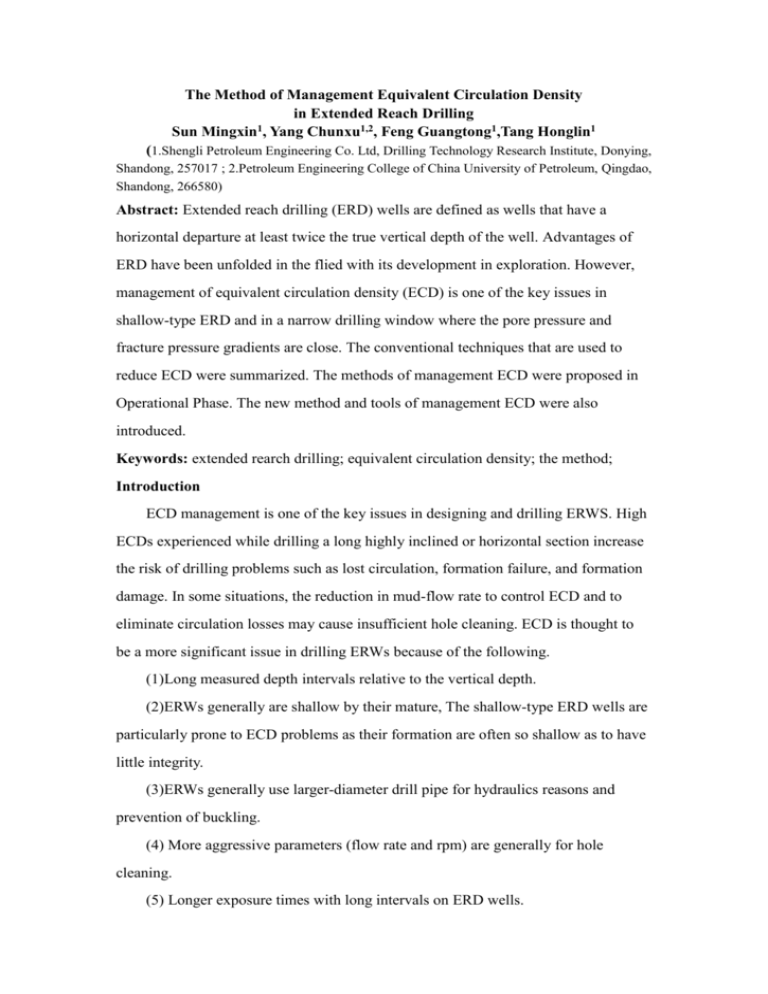shallow formation
advertisement

The Method of Management Equivalent Circulation Density in Extended Reach Drilling 1 Sun Mingxin , Yang Chunxu1,2, Feng Guangtong1,Tang Honglin1 (1.Shengli Petroleum Engineering Co. Ltd, Drilling Technology Research Institute, Donying, Shandong, 257017 ; 2.Petroleum Engineering College of China University of Petroleum, Qingdao, Shandong, 266580) Abstract: Extended reach drilling (ERD) wells are defined as wells that have a horizontal departure at least twice the true vertical depth of the well. Advantages of ERD have been unfolded in the flied with its development in exploration. However, management of equivalent circulation density (ECD) is one of the key issues in shallow-type ERD and in a narrow drilling window where the pore pressure and fracture pressure gradients are close. The conventional techniques that are used to reduce ECD were summarized. The methods of management ECD were proposed in Operational Phase. The new method and tools of management ECD were also introduced. Keywords: extended rearch drilling; equivalent circulation density; the method; Introduction ECD management is one of the key issues in designing and drilling ERWS. High ECDs experienced while drilling a long highly inclined or horizontal section increase the risk of drilling problems such as lost circulation, formation failure, and formation damage. In some situations, the reduction in mud-flow rate to control ECD and to eliminate circulation losses may cause insufficient hole cleaning. ECD is thought to be a more significant issue in drilling ERWs because of the following. (1)Long measured depth intervals relative to the vertical depth. (2)ERWs generally are shallow by their mature, The shallow-type ERD wells are particularly prone to ECD problems as their formation are often so shallow as to have little integrity. (3)ERWs generally use larger-diameter drill pipe for hydraulics reasons and prevention of buckling. (4) More aggressive parameters (flow rate and rpm) are generally for hole cleaning. (5) Longer exposure times with long intervals on ERD wells. The Effects of ECD High ECD’s increase the risk of lost circulation, especially while (1)drilling 81/2” or smaller hole size, or (2) while running or circulating long casing strings. Further, reservoir damage can be a side effect if ECD’s are not minimized. Wellbore instability can be caused by the constant flexing and relaxing of the wellbore when the pumps are turned on and off. This is particularly the case if the formation is brittle formation. Effectively, the wellbore is failed through fatigue, as would a paper clip when bent back and forth. A paper clip can be bent back and forth once or twice without breaking, even if it is bent quite severely. It will break due to fatigue failure if it is bent enough times. The time to failure is dependent upon(1)how severe the bending is (2)how many times it is bent, (3)the strength and elasticity of the material. It is the same with the wellbore and ECD fluctuations. The wellbore can eventually fail, depending on the lithology, and the size and frequency of ECD fluctuations. Casing collapse can be initiated by ECD’s while running buoyancy assisted casing strings on long, deep ERD wells, Casing collapse calculations should account for the increased annular pressure due to ECD’s while running casing, rather than just for a static on-bottom scenario. Long mud-over-air casing flotation jobs have experienced collapsed casing due to the running ECD’s alone. Surge pressure creates a “piston fore” that behaves like drag. This can be critical for marginal casing runs. An indirect effect will be the impact on hole cleaning if losses are encountered due to ECD’s. In an effort to reduce losses, flow rates will be reduced. This will result in poorer hole cleaning and a build up of cuttings in the hole. In turn, ECD’s will become worse and a vicious cycle is started. The reduction in flow rate will also have a negative impact on torque and drag, and drilling performance. The conventional techniques that are used to reduce ECD Current conventional techniques that are used to reduce ECD include: (1)Using low fluid rheologies to reduce frictional losses. (2)Using drillstrings and casing strings that provide greater annular clearance. (3)Using expandable tubulars to increase hole size. (4)Use of drilling liners in place of casing strings. (5)Reducing flow rates to decrease frictional losses. (6)Reducing penetration rates to reduce the amount of cuttings in the annulus. These techniques can solve ECD problems but can result in higher drilling costs. The higher drilling costs could make some wells uneconomical to drill. Dualgradient drilling and riserless drilling also can reduce ECD but can have higher capital expenditures than an ECD reduction tool. The method of management ECD in Operational Phase The numerous options were presented, which were used to help reduce ECD’s on ERD wells in planning phase. The usual field practice is to treat ECD’s as an after-thought. So, in this papers the numerous options were proposed, which could provided the guidance for field operation. 1.Flowrate and RPM Reducing flow rates is generally the first option if ECD’s are an issue. It is important that any reduction in flowrates is within the hole cleaning limitations of the drilling system. But the minimum allowable flowrate will be dependent upon many factors, such as mud rheology, rpm, slide frequency, hole size, ROP and other practices. If ECD’s are critical, prior to drilling out the shoe, it may prove beneficial to measure the magnitude of ECD variations with a range of flowrates and RPM’s. This should be done by completing an ECD matrix with a PWD tool. Note that the mud will need to be circulated for an adequate length of time to shear and warm it, and therefore obtain good quality data. 2.ROP Downhole annular pressure is directly related to the amount of cuttings that are in the hole. The weight of these cuttings adds weight to the fluid, just as barite does. Hence, the more cutting that are in the hole, the higher the effective bottom hole pressure. Therefore, there is merit in controlling ROP if ECD’s are critical. 3.Slide Drilling Practices Slide drilling results in the build-up of a cuttings dune immediately above the BHA. Down hole MWD pressure tools have shown that bottom hole pressure can increase sharply when pipe rotation is initiated after a long slide interval. This is because of the instantaneous lifting of this cutting dune into the flow regime, there is also increased risk of packing off during this time. If ECD’s are an issue, then slide intervals should be broken up with pipe rotation so as to redistribute the cuttings more evenly up the hole. 4. Back reaming As with slide drilling, back reaming can cause a significant cuttings dune to form, which can increase bottom-hole pressure if the cuttings dune is disturbed suddenly. This is particularly true if the well has been circulated out prior to back reaming. Circulating out of the hole cleans around the BHA, but the absence of rotation allows cuttings to fall out and build up directly above the BHA. The initiation of back reaming, at this stage, must be done with care. The New techniques that are used to reduce ECD 1. Continuous Circulation System The continuous circulation system (CCS) is a new technology that enables a driller to make connections without stopping fluid circulation. A CCS enables a driller to maintain a constant ECD when making connections. In normal drilling operations, a driller must turn the pumps off when making a connection. Numerous problems can occur as pumps start and stop in a drilling operation. Fig. 1.Change in equivalent mud weight during connections Fig. 1 shows the pressure spikes that occur when making a connection. When the pumps stop, the pressure in the well decreases. This decrease in pressure can cause a kick, formation fluids enter the wellbore. The formation could also relax and the formation could collapse on the hole, resulting in stuck pipe. The differential pressure between the reservoir and the wellbore can also stick the pipe. The drilling fluid starts to form a gel when the pumps are turned off as the fluids stop circulating. When the pumps are restarted, pressure increases to break the gel, causing a pressure spike which could cause lost circulation, where fluids enter the formation, and ballooning of the wellbore. Before a connection is made, the rig has downtime associated with circulating the cuttings out of the bottom-hole assembly. This is required so that the cuttings do not settle at the bottom-hole assembly. A CCS could solve these problems when drilling. It would enable a driller to have improved control of the ECD and reduce these problems that can result from shutting down the pumps during a connection. 2.The ECD reduction tool The ECD reduction tool is designed to reduce the bottom-hole pressure increase caused by friction in the annulus by providing a pressure boost up annulus. The tool has three basic parts. The top section of the tool has a turbine motor that is powered by the circulating fluid. The middle section consists of a mixed flow pump that is partly axial and partly centrifugal. This section pumps the fluid up the annulus. The bottom section consists of the bearing and seals. Two nonrotating packer-cup seals in the lower section of the tool provide the seal between the tool and the casing. This causes all the return fluid to flow through the pump. A potential disadvantage of the ECD reduction tool is the surge and swab effects that could occur during tripping. Surge refers to the down hole pressure increase due to the downward movement of the drill string in the well. Swab refers to a decrease in down hole pressure when the drill string is being pulled out of the hole. The ECD reduction tool can be used in onshore and offshore environments to help prevent problems associated with drilling wells that have narrow pressure windows. It can help alleviate high ECD that could result in formation damage and mud loss. It may be useful as a low cost alternative to other ECD-reduction techniques. Conclusions 1. Managed ECD can improve the economic drill ability of wells. It can help solve many of the problems that result from pressure variations in the formations. 2. The method of management ECD ought to been carried out an in-depth study in Operational Phase, in order to scientifically guide the drilling ERWs. 3. The Continuous Circulation System allows the pressure profile to remain consistent when making connections. It prevents pressure spikes that can occur when turning the pumps on and off. 4. The ECD reduction tool reduces the dynamic pressure profile of a well from the point where the tool is installed on the drill string to the bottom of the hole. If the tool passes the narrow pressure margin while drilling, the tool would cease to have any effect on the pressure at that point. The pressure could exceed the fracture pressure and cause lost circulation. Acknowledgements This work was financially supported by 863 Project which the name was development and integration of extended well offshore drilling and completion technology (2012AA091501). And the project was undertaken by Shengli Petroleum Engineering Co. Ltd, Drilling Technology Research Institute. References Shigemi Naganawa, SPE, U. of Tokyo; and Komei Okatsu, SPE, JOGMEC.2008. Fluctuation of Equivalent Circulating Density in Extended Reach Drilling with Repeated Formation and Erosion of Cuttings Bed.SPE115149 Mims, M., Krepp, T., Williams, H., Conwell, R., and Navarro, A. 2002. Drilling Design and Implementation for Extended Reach and Complex Wells, Third Edition, K&M Technology Group, LLC. Qi Yutong. The method of equivalent density control in the process of drilling cycle equivalent density. Yangtze university institute of petroleum engineering. China petroleum machinery,2008,36(3):74~76







